| Authors: | Ángeles G. Mayor, V Ramón Vallejo, Susana Bautista with Peter de Ruiter, Lia Hemerik, Violette Geissen, Jaap Bloem, Jacob Kéizer, Óscar González-Pelayo, Ana Isabel Machado, Ana Vasques, Christel van Eck, Martinho Martins, Paula Maia, Alejandro Valdecantos, Jaime Baeza, Joan Llovet and David Fuentes |
| Editor: | Jane Brandt |
| Source document: | Mayor et al. (2015) Identification of critical changes preceding catastrophic shifts: ecosystems affeced by increasing wildfire recurrence. CASCADE Project Deliverable 3.1a |
Values of soil organic C and nutrients in relation to fire recurrence, and ANOVA results for each soil variable of Várzea study site are shown in Figure. 1 and Table 2, respectively. Although not significantly different, soil organic C showed higher values in burned than in unburned soils eight months after the occurrence of the last fire.
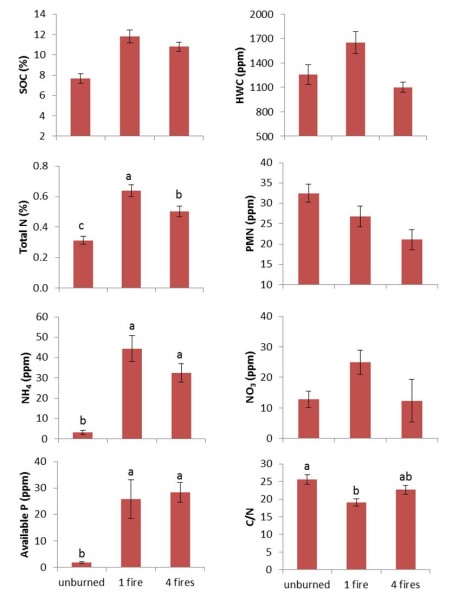
Figure 1 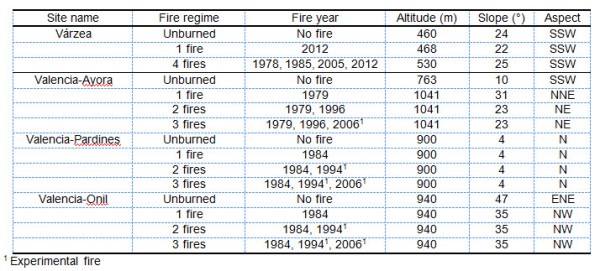
Table 1
Hot-water extractable C was however similar for burned and unburned soils but decreased from 1 fire to 4 fires. HWC:SOC ratio was significantly lower in 4 fires than in 1 fire or unburned sites (Figure 2). Similar to soil organic C, total N was higher in burned than in unburned soils, but values significantly decreased with increasing fire recurrence. However, the potentially mineralizable N decreased from unburned to 4 fires, and thus, its value relative to total N was lower in burned than in unburned soils, without differences between areas burned once or four times (Figure 2). Both NH4 and available P showed a trend with lower values for unburned than for burned soils, and without differences between soils burned one or four times. Microsite did not have any significant effect on any of the soil variables (Table 2).
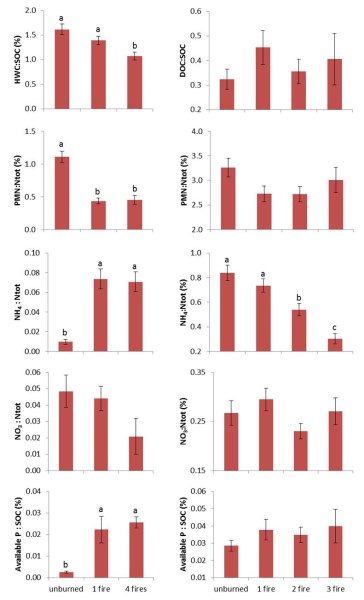
Figure 2 
Table 2
The first two components of the PCA performed with the soil organic matter quantity matrix had eigenvalues higher than one and together explained over 60% of the variance in the data (Figure 3). Soil organic C, total N, and NH4 were significantly correlated (ІρІ≥0.6) with the first component. Hot-water C and potentially mineralizable N were correlated with the second component. Also the two first components of the PCA performed with the soil organic matter quality matrix had an eigenvalue higher than one, explaining over 65% of the total variance (Figure 3). The ratios PMN:N and HWC:SOC, and Pava:SOC and NH4:N, showed the strongest correlations with the first component (positively and negatively, respectively), while the NO3:N ratio was most strongly related to the second component.
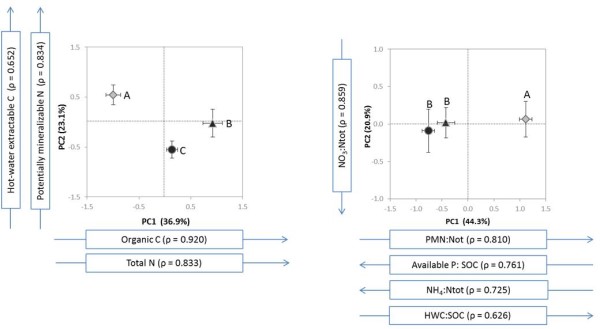
Figure 3 
Table 3
Fire recurrence had a significant effect on the first component of the PCA performed with the soil organic matter quantity matrix (Figure 3, Table 3). This component was higher for burned than for unburned soils, but decreased with fire frequency so that values for one fire were higher than for four fires. On the contrary, the second component decreased from unburned to four fires, although differences were not significant in this case. Microsite had no significant effect on any of the two components.
However, the interaction between the two factors (Recurrence X Microsite) was marginally significant for the second component. Indeed, when the analysis of variance was performed for both microsites separately (plant patches of P. tridentatum or intershrub spaces), the second component was significantly higher in unburned than in burned soils only for the intershrub microsite, without differences between 1 and 4 fires (F = 5.082, p = 0.015, Figure 4). Fire recurrence also had a significant effect on the first component of the PCA performed with the soil organic matter quality matrix, being higher for unburned than for burned soils, without differences between 1 or 4 fires (Figure 2). Microsite did not significantly affect any of the two components of the PCA performed with the quality matrix.
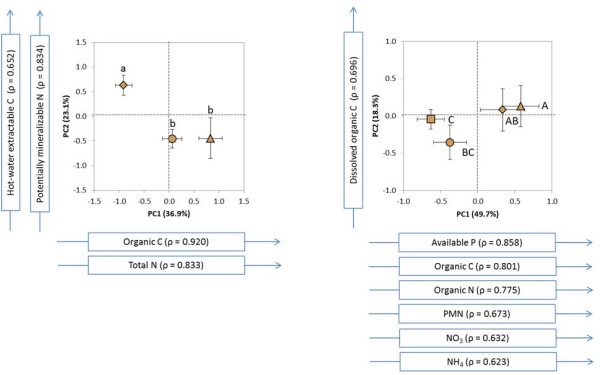
Figure 4
Note: For a full description the context within which this work at Várzea was done and the methods used, see
